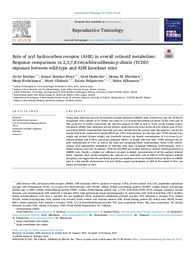Por favor, use este identificador para citar o enlazar este ítem:
https://hdl.handle.net/11000/37573Registro completo de metadatos
| Campo DC | Valor | Lengua/Idioma |
|---|---|---|
| dc.contributor.author | Esteban Mozo, Javier | - |
| dc.contributor.author | Sánchez Pérez, Ismael | - |
| dc.contributor.author | Hamscher, Gerd | - |
| dc.contributor.author | Miettinen, Hanna | - |
| dc.contributor.author | Korkalainen, Merja | - |
| dc.contributor.author | Viluksela, Matti | - |
| dc.contributor.author | Pohjanvirta, Raimo | - |
| dc.contributor.author | Hakansson, Helen | - |
| dc.contributor.other | Departamentos de la UMH::Biología Aplicada | es_ES |
| dc.date.accessioned | 2025-09-29T13:04:40Z | - |
| dc.date.available | 2025-09-29T13:04:40Z | - |
| dc.date.created | 2021-02-16 | - |
| dc.identifier.citation | Reproductive Toxicology, Volume 101, April 2021, Pages 33-49 | es_ES |
| dc.identifier.issn | 1873-1708 | - |
| dc.identifier.issn | 0890-6238 | - |
| dc.identifier.uri | https://hdl.handle.net/11000/37573 | - |
| dc.description.abstract | Young adult wild-type and aryl hydrocarbon receptor knockout (AHRKO) mice of both sexes and the C57BL/6J background were exposed to 10 weekly oral doses of 2,3,7,8-tetrachlorodibenzo-p-dioxin (TCDD; total dose of 200 μg/kg bw) to further characterize the observed impacts of AHR as well as TCDD on the retinoid system. Unexposed AHRKO mice harboured heavier kidneys, lighter livers and lower serum all-trans retinoic acid (ATRA) and retinol (REOH) concentrations than wild-type mice. Results from the present study also point to a role for the murine AHR in the control of circulating REOH and ATRA concentrations. In wild-type mice, TCDD elevated liver weight and reduced thymus weight, and drastically reduced the hepatic concentrations of 9-cis-4-oxo-13,14- dihydro-retinoic acid (CORA) and retinyl palmitate (REPA). In female wild-type mice, TCDD increased the hepatic concentration of ATRA as well as the renal and circulating REOH concentrations. Renal CORA concentrations were substantially diminished in wild-type male mice exclusively following TCDD-exposure, with a similar tendency in serum. In contrast, TCDD did not affect any of these toxicity or retinoid system parameters in AHRKO mice. Finally, a distinct sex difference occurred in kidney concentrations of all the analysed retinoid forms. Together, these results strengthen the evidence of a mandatory role of AHR in TCDD-induced retinoid disruption, and suggest that the previously reported accumulation of several retinoid forms in the liver of AHRKO mice is a line-specific phenomenon. Our data further support participation of AHR in the control of liver and kidney development in mice. | es_ES |
| dc.format | application/pdf | es_ES |
| dc.format.extent | 17 | es_ES |
| dc.language.iso | eng | es_ES |
| dc.publisher | Elsevier | es_ES |
| dc.rights | info:eu-repo/semantics/openAccess | es_ES |
| dc.rights | Attribution-NonCommercial-NoDerivatives 4.0 Internacional | * |
| dc.rights.uri | http://creativecommons.org/licenses/by-nc-nd/4.0/ | * |
| dc.subject | Aryl hydrocarbon receptor | es_ES |
| dc.subject | 2,3,7,8-Tetrachlorodibenzo-p-dioxin | es_ES |
| dc.subject | TCDD | es_ES |
| dc.subject | Genetically modified organisms | es_ES |
| dc.subject | Retinoids | es_ES |
| dc.subject | Vitamin A | es_ES |
| dc.subject.other | CDU::5 - Ciencias puras y naturales::57 - Biología | es_ES |
| dc.title | Role of aryl hydrocarbon receptor (AHR) in overall retinoid metabolism: Response comparisons to 2,3,7,8-tetrachlorodibenzo-p-dioxin (TCDD) exposure between wild-type and AHR knockout mice | es_ES |
| dc.type | info:eu-repo/semantics/article | es_ES |
| dc.relation.publisherversion | https://doi.org/10.1016/j.reprotox.2021.02.004 | es_ES |

Ver/Abrir:
Esteban.pdf
4,36 MB
Adobe PDF
Compartir:
 La licencia se describe como: Atribución-NonComercial-NoDerivada 4.0 Internacional.
La licencia se describe como: Atribución-NonComercial-NoDerivada 4.0 Internacional.
.png)